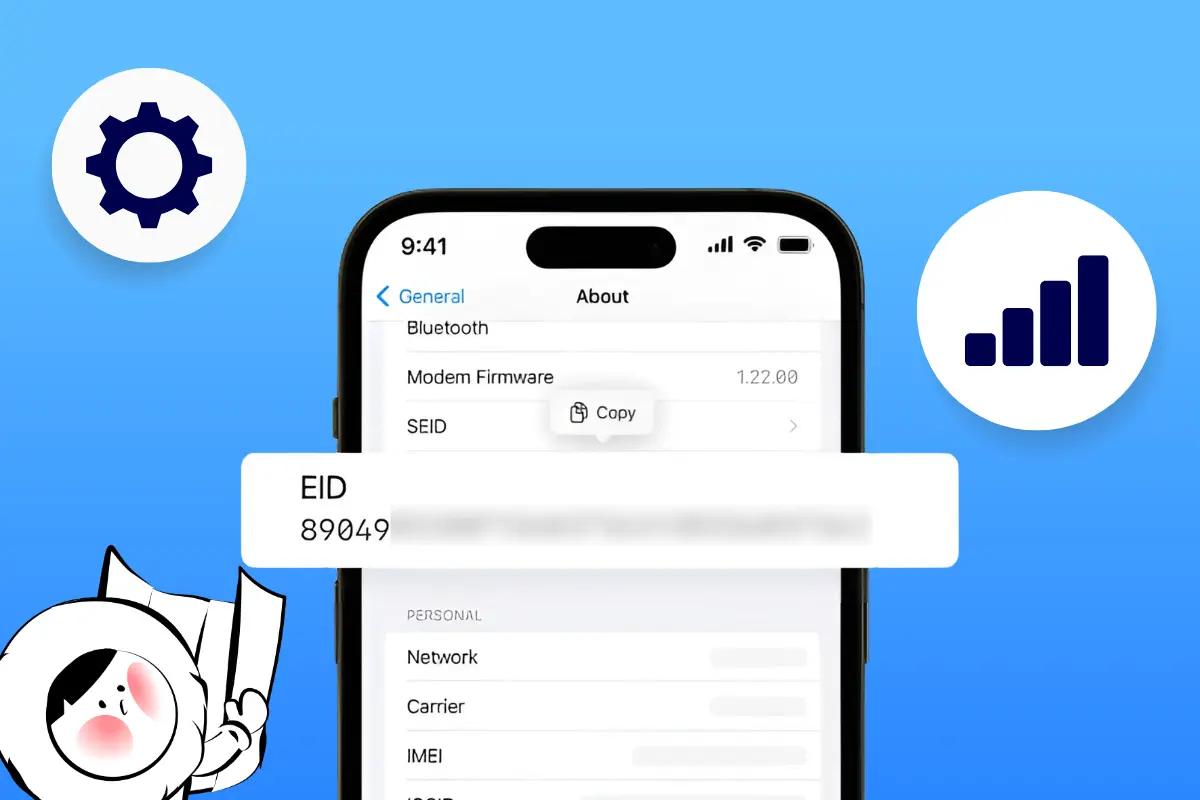In today's rapidly evolving mobile technology landscape, understanding the components that enable seamless connectivity is essential. One such component is the EID (Embedded Identity Document), a crucial element in the realm of eSIM technology. Understanding what it does will lead to more flexibility in your connectivity solutions.

What is EID on a Phone?
An EID is a unique 32-digit identifier embedded into devices equipped with eSIM (embedded SIM) technology. This identifier is permanently assigned during the manufacturing process and serves as a digital signature that verifies the authenticity of the device. The EID plays a pivotal role in the activation and management of eSIM profiles, distinguishing it from traditional identifiers like ICCID (Integrated Circuit Card Identifier) and IMEI (International Mobile Equipment Identity).
Importance of the EID in eSIM Technology
Simply put, having an EID equals a device's eSIM compatibility.
Let's Go with a Fun Analogy
Using online shopping as an example;
eSIM: You.
EID: Your address.
eSIM Profiles: That pair of shoes, new gadgets, or anything you're passionate about online.
eSIM Installation: When you press that glowing BUY button and confirm your purchase.
Telcos: The seller you're buying the product from.
So, the Flow Looks Like This
I've been eyeing Vivo X200 Pro (I'm definitely thinking about its eSIM compatibility and not its gorgeous camera).
- I see the phone online and complete all the steps for the purchase (eSIM Installation).
- The seller receives my order (Telcos).
- Once processed, the seller will send the Vivo X200 Pro (eSIM profile) to my address (EID).
- Once delivered, I (eSIM) can now use the Vivo X200 Pro (eSIM profile).
Other EID Benefits
The EID is integral to the functionality of eSIMs, offering several benefits:
- Device Authentication: Ensures the correct eSIM profile is provisioned to your eSIM, facilitating seamless connectivity.
- Security: Acts as a unique identifier and is heavily encrypted, adding a layer of security to your device's cellular capabilities.
- OTA (Over-the-air) Activation: This is a key component that enables remote activation for your eSIM profile.
How to Find Your Device's EID
Locating your device's EID is straightforward but varies slightly depending on the operating system:
On iOS Devices (iPhone/iPad):
- Open the Settings app.
- Tap on General.
- Select About.
- Scroll down to find the EID number listed.

The screenshot is taken from my colleague's iPhone 13. EID is shown here as the device is eSIM compatible.
On Android Devices:
- Open the Settings app.
- Tap on About Phone or About Device.
- Select Status or IMEI Information.
- Locate the EID number within the details.
Note: The steps to locate your EID may vary slightly depending on your device's manufacturer and operating system version.
Alternative Method for All Devices:
- Dial
*#06#on your device's keypad. This action will display various identifiers, including the EID if your device supports eSIM.

A screenshot showing *#06# on my Android, POCO F4 GT dial pad, an eSIM incompatible device, that shows IMEI details but no EID

A screenshot showing *#06# on my colleague's iPhone 13's dial pad, an eSIM compatible device, that shows IMEI and EID details
EID vs IMEI vs ICCID
While all three values are identifiers, they serve different purposes:
- EID (Embedded Identity Document): Identifies the eSIM chip (32 digits).
- IMEI (International Mobile Equipment Identity): Identifies your mobile device (15 digits).
- ICCID (Integrated Circuit Card Identifier): Identifies a physical SIM card or, in the context of an eSIM, the eSIM profile (18 or 19 digits).
Understanding these identifiers is crucial, especially when troubleshooting with a provider's technical support.
My Device Has an EID but I Can't Install an eSIM
There are a few possible causes:
- Full Storage: You have hit the maximum number of eSIMs allowed on your device. Kindly check with your manufacturer for your device's eSIM capacity. If you have an inactive or expired eSIM, try removing it.
- Network Lock: Your device could be network-locked. If so, you'd need to contact your primary provider for assistance.
- Installed Elsewhere: Your eSIM profile could have been installed on another device. Like with traditional SIM cards, an eSIM profile can only be active on a device at any one time.
- Invalid Codes: Your eSIM QR code or Activation code could have been used for installation and has exceeded its innate installation limit. Kindly contact your provider for more assistance.
Conclusion
As eSIM technology continues to evolve, the significance of the EID will only grow. With the adoption of eSIM technology, the EID number offers several advantages, especially for frequent travelers, tech enthusiasts, and those who value flexibility - and there's no better start than with Eskimo eSIM, with Tier 1 network partners in 130+ countries. Try now for free (limited-time only) by signing up!

















